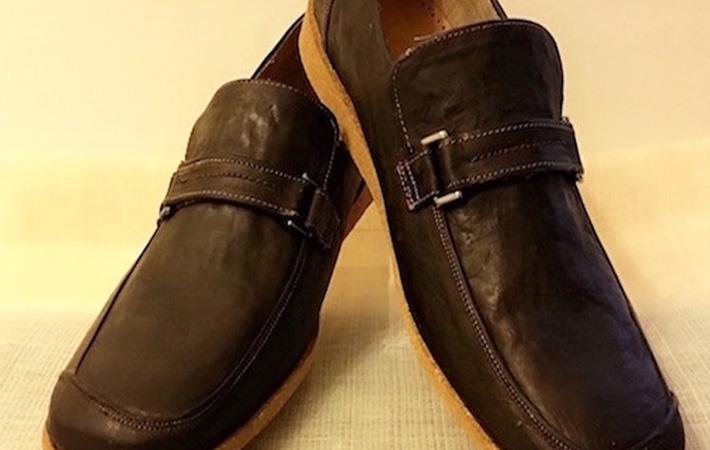Scientists at the Auburn University have developed a biodegradable material using the byproducts of fermented green tea, and found that it behaved the same way as leather, without the negative environmental side effects. The material has the potential to be used for making shoes. The research was done using an Environmental Protection Agency-funded grant.
The research was done by researcher Young-A Lee and her team.Scientists at the Auburn University have developed a biodegradable material using the byproducts of fermented green tea, and found that it behaved the same way as leather, without the negative environmental side effects. The material has the potential to be used for making shoes. The research was done using an Environmental Protection Agency-funded grant.#
Studies show that the materials commonly used to make footwear contribute to environmental deterioration and can have negative effects on workers’ health. Today’s dress shoes are most commonly made from a variety of rubber, leather and synthetic materials that take decades to decompose.
Lee collaborated with her former doctoral student, Changhyun Nam at Iowa State University, and proposed testing the viability of the sustainable, multi-layered cellulosic material in comparison with traditional footwear materials. They hypothesised that the biodegradable and traditional materials would have similar properties when it came to how comfortable, durable and thermal-resistant the shoes would be for the wearer.
Lee was inspired by cradle-to-cradle design framework, which is a principle focused on the renewability of products. She said her curiosity about turning food waste into fashion was what sparked the research.
“Our research team was looking for sustainability design practices starting from fibre, to product design and development to the end - consumers. We started to explore alternative materials for leather and synthetic textiles, focusing more on natural fibres,” Lee said. “At the same time, we also searched whether there is any way for us to use byproducts from various industries to generate new materials for apparel-related products.”
In her research at Iowa State University, Lee found that a green tea-based cellulosic material behaved the same way as leather, without the same negative environmental side effects. However, a single layer of this material may soften in rain or snow and lose its durability. But by layering this material with other eco-friendly fabrics, a much more durable product can be created.
Men’s leather dress shoes are made up of the upper and inner shells, the insole, the midsole and the outsole. Leather is commonly used because of its durable, flexible and stylish qualities. When the researchers combined an outer shell of cellulosic material with a hemp-based fabric on the inside, then used recycled denim to bond the two together, the result was an eco-friendly product comparable to the style and durability of a leather dress shoe.
Once a similar-looking shoe prototype was designed, Lee’s team tested its thickness, weight, air permeability, thermal comfort, tensile strength and wettability as compared to commercially available leather. The team found that the sustainable model has the potential to be used as the entire shell of the shoe due to its lightness and airflow capability coupled with the durable nature of the fermented green tea-based material. In terms of thermal comfort, the sustainable model provided similar or even better results than the leather model.
Human wear trials using the model to further confirm this finding were also carried out. As for the wearer’s comfort and performance ability, the sustainable model provided more benefits than the leather model. They also found that the two shoes had similar levels of break force and flexibility, meaning that overall, the shoes would last for the same amount of time and withstand the same amount of pressure before being damaged. The only value in which the leather shoe had an advantage over the sustainable shoe was in wettability – the measure of how water permeable the material is and how long it takes to dry.
Lee said this project is still under investigation while researchers explore ways to make the shoes less water-absorbent before they’re viable for daily wear. However, it’s a great start for a more sustainable design, Lee said.
“Fashion, to most people, is an ephemeral expression of culture, art and technology manifesting itself in form,” Lee said. “Fashion companies keep producing new materials and clothing, from season to season, year to year, to fulfil consumers' desire and needs. This is really the time to think about where these items eventually go. We really need to think about new ways of creating sustainable materials and products made out of those, which contributes to the betterment of people, the planet and our society. Along that line, I as an educator need to be proactive to educate future apparel designers and developers to be change agents to lead this sustainable, healthy movement in the industry.” The study concluded that the multi-layered, biodegradable material presented great potential as a substitute to leather. The finding will lead to more research in sustainable apparel and footwear practices.
Work has also been done to create various types of renewable products including baby shoes, vests and bags, with the potential to create more sustainable apparel.
Associate dean for research Jennifer Kerpelman said this type of research exemplifies the use of science to find practical solutions to everyday problems. “As a human scientist, Dr. Lee is conducting research that represents the innovation necessary to meet the needs of the consumer market while also supporting the planet’s health and sustainability,” Kerpelman said.
Fibre2Fashion News Desk (SV)
